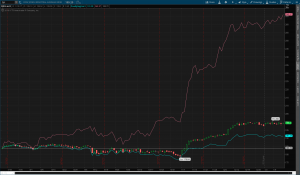The growth of banking stocks in the last few quarters have had a significant impact on the bull market, but there is a catch. While everything seems to be doing great in the markets, a good portion of the recent growth has been due to banking stocks, and that is not necessarily a good thing.
The DJIA, while not the best indicator for market health, is one of the most widely used ones, so let’s look at the DJIA both with and without its banking stocks: Goldman Sachs, JP Morgan Chase, and American Express. The analysis is simple, so long as the time period all has the same divisor, because the DJIA is price weighted: sum up the three banking stocks, sum up the remaining stocks, divide those sums by the first closing value, and then multiply by the DJIA first closing value.
Here are the results, obtained through ThinkOrSwim.

Along with the DJX (DJIA divided by 100), there is the pink line, which represents the banking stocks, the blue line, which represents the remaining stocks, and the grey line, which is the baseline DJX value. There’s nothing worrisome about that data, by itself. But it becomes troubling when we look into why banking stocks have been doing so well.
In October, Goldman Sachs reported a 19% rise in third quarter revenues. According to Forbes, the reason for the better than expected earnings was the trading surge during the quarter. But what caused the trading surge? The answer is, the bull market. So it seems that there is a clear positive feedback mechanism currently in play, between the banking industry and the market, and it is a significant component of the overall dynamics of the market. This also suggests that if either starts to fail, the failure will be amplified.
There are a number of different ways in which this can happen. One of the biggest concerns is the credit bubble that’s been forming, around absurdly low interest rates, for some time. According to the January consumer credit report, the provisional percent change in consumer credit for November was 7.9% (annual rate), higher than either September or October’s increase; the provisional rate for Q3 of 2016 was 7.3% (annual rate) which was higher than the preceding four quarters; the total outstanding consumer debt for November was estimated at $1.5T.
If interest rates rise too far—and they really need to rise—defaults could increase considerably, cutting into the earnings of banks. Once this happens and it results in a worse than expected earnings report, banking stocks will decline, taking energy out of the bull market; as the energy is taken out of the bull market, people will trade less, thus further cutting into the revenue streams of the banks. What is even more concerning is that we are already seeing an increase in defaults: according to Barrons, global defaults in 2016 were at their highest level since 2009.
The main scenario that could pull us out of this mess is if somehow the economy as a whole started to pick up and the rest of the major stocks began outperforming. But this does not seem likely.
Further Reading
- Why I am Concerned about the Markets

